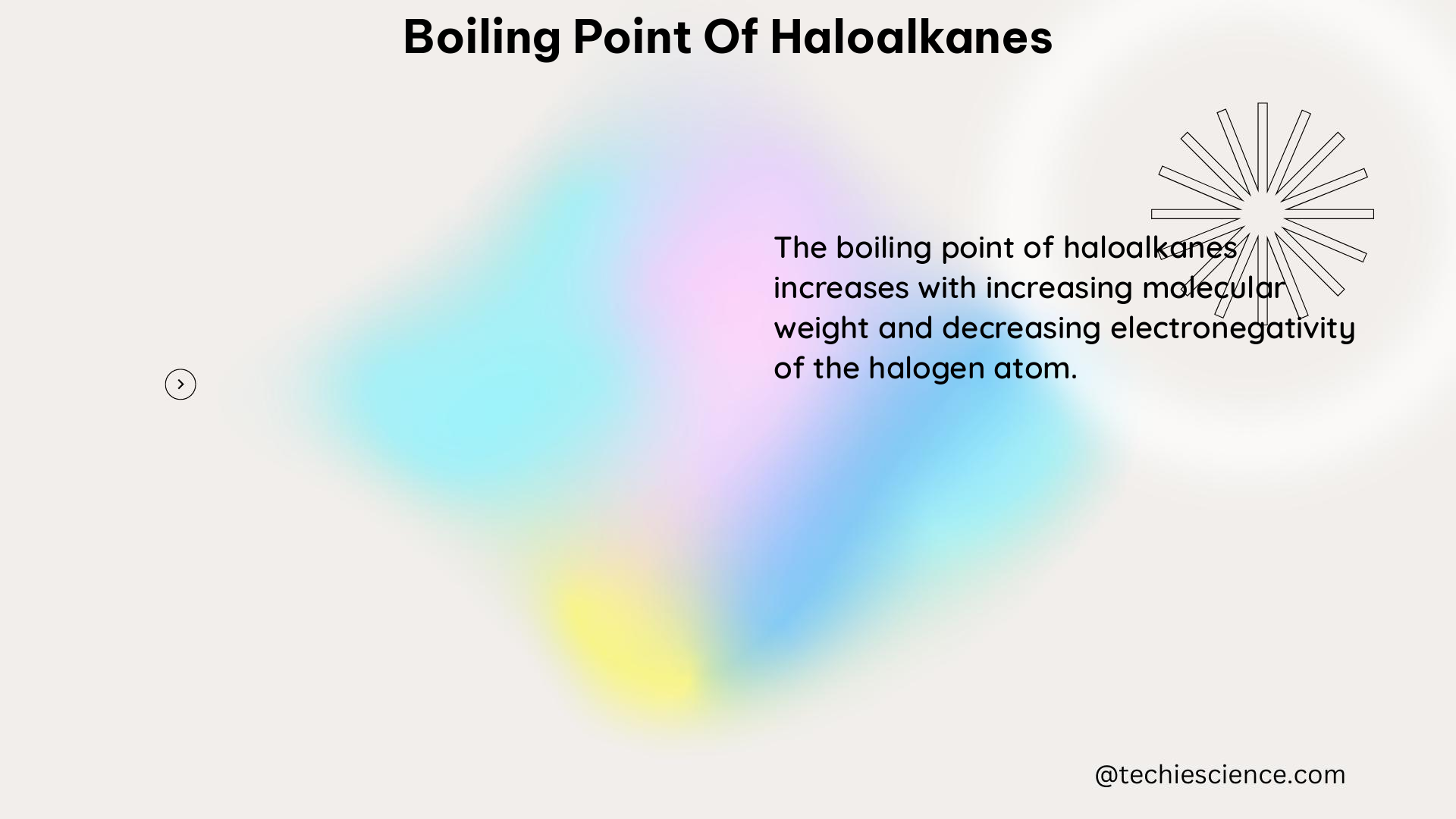The boiling points of haloalkanes, a class of organic compounds containing a halogen atom (F, Cl, Br, or I) bonded to an alkyl group, are intriguing phenomena that are influenced by a complex interplay of molecular properties. Understanding the factors that govern these boiling points is crucial for chemists, physicists, and engineers working with haloalkanes in various applications, from refrigeration to pharmaceutical synthesis.
Molecular Mass and Boiling Point: The Heavier, the Higher
One of the primary factors that dictates the boiling point of haloalkanes is their molecular mass. As the number of atoms in the molecule increases, so does the overall mass, leading to a rise in the boiling point. This relationship can be quantified using the following equation:
$T_b = \frac{A}{B – \log P}$
Where:
– $T_b$ is the boiling point (in Kelvin)
– $A$ and $B$ are constants that depend on the nature of the haloalkane
– $P$ is the vapor pressure of the haloalkane
For example, the boiling point of methane (CH4) is a mere -161.5°C, while the boiling point of chloromethane (CH3Cl) is -23.8°C, and the boiling point of bromomethane (CH3Br) is 3.6°C. This trend holds true for larger haloalkanes as well, with the boiling point of 1-bromobutane (C4H9Br) reaching a relatively high 150.8°C.
Branching: Compact Structures, Lower Boiling Points

Another crucial factor influencing the boiling points of haloalkanes is the degree of branching in the molecule. Branched haloalkanes generally have lower boiling points compared to their linear counterparts. This can be attributed to the more compact and efficient packing of the branched molecules, which reduces the intermolecular forces and, consequently, the boiling point.
For instance, the boiling point of isobutane (2-methylpropane) is -11.7°C, while the boiling point of n-butane (linear butane) is -0.5°C. The additional methyl group in isobutane creates a more compact structure, leading to a lower boiling point.
Halogen Atoms: Polarity and Boiling Point Elevation
The presence of halogen atoms (F, Cl, Br, or I) in haloalkanes also plays a significant role in determining their boiling points. Halogens are highly electronegative elements, which means they have a strong tendency to attract electrons. This results in a polar C-X bond (where X is the halogen atom), with the carbon atom bearing a partial positive charge and the halogen atom bearing a partial negative charge.
These polar interactions lead to stronger intermolecular forces, such as dipole-dipole interactions and London dispersion forces, which in turn increase the boiling points of haloalkanes. For example, the boiling point of chloroethane (C2H5Cl) is 12.3°C, while the boiling point of ethane (C2H6) is -88.6°C, a difference of over 100°C.
Haloalkanes vs. Alkanes: Polarity Matters
Comparing haloalkanes to their alkane counterparts (compounds containing only carbon and hydrogen atoms) reveals another interesting trend. Haloalkanes generally have higher boiling points than alkanes of similar molecular mass. This is due to the polar nature of the C-X bond in haloalkanes, which leads to stronger intermolecular forces and, consequently, higher boiling points.
For instance, the boiling point of methane (CH4) is -161.5°C, while the boiling point of chloromethane (CH3Cl) is -23.8°C, a difference of over 130°C. This trend holds true for larger haloalkanes and alkanes as well, with the boiling point gap widening as the molecular mass increases.
Haloalkanes vs. Alcohols and Amines: Hydrogen Bonding Dominates
While haloalkanes have higher boiling points than alkanes of comparable molecular mass, they generally have lower boiling points than alcohols and amines. This is because alcohols and amines can participate in hydrogen bonding, a particularly strong intermolecular force that is absent in haloalkanes.
Hydrogen bonding occurs when the highly electronegative oxygen or nitrogen atoms in alcohols and amines, respectively, form attractive interactions with the hydrogen atoms of neighboring molecules. This additional intermolecular force significantly increases the boiling points of alcohols and amines compared to haloalkanes of similar molecular mass.
For example, the boiling point of ethanol (C2H5OH) is 78.3°C, while the boiling point of chloroethane (C2H5Cl) is only 12.3°C, a difference of over 60°C.
Quantitative Data: Boiling Points of Common Haloalkanes
To further illustrate the trends discussed, here is a table of the boiling points for some common haloalkanes:
| Haloalkane | Boiling Point (°C) |
|---|---|
| Chloromethane (CH3Cl) | -23.8 |
| Bromomethane (CH3Br) | 3.6 |
| Chloroethane (C2H5Cl) | 12.3 |
| 1-Chloropropane (C3H7Cl) | 46.7 |
| 1-Bromopropane (C3H7Br) | 91.2 |
| 1-Chlorobutane (C4H9Cl) | 78.5 |
| 1-Bromobutane (C4H9Br) | 150.8 |
This data clearly demonstrates the relationship between molecular mass, halogen type, and boiling point, as discussed earlier. As the carbon chain length increases and the halogen atom becomes heavier, the boiling points of the haloalkanes rise accordingly.
Conclusion
The boiling points of haloalkanes are a complex and fascinating topic, influenced by a delicate balance of molecular properties, including mass, branching, and the presence of halogen atoms. Understanding these factors is crucial for chemists, physicists, and engineers working with haloalkanes in various applications.
By exploring the quantitative relationships and trends discussed in this article, you can develop a deeper understanding of the boiling point behavior of haloalkanes, enabling you to make informed decisions and predictions in your work. This knowledge can be applied to a wide range of fields, from chemical process design to the development of novel haloalkane-based materials and technologies.
References
- Studypool. “Physical and Chemical Properties of Monohaloalkanes.” https://www.studypool.com/documents/8791836/physical-and-chemical-properties-of-monohaloalkanes
- Neuman, Robert. “Haloalkanes, Alcohols, and Amines.” https://people.chem.ucsb.edu/neuman/robert/orgchembyneuman.book/03%20HaloalkanesAlcoholsAmines/03Separates/03Text.pdf
- Master Organic Chemistry. “Activating and Deactivating Groups in Electrophilic Aromatic Substitution.” https://www.masterorganicchemistry.com/2017/09/26/activating-and-deactivating-groups-in-electrophilic-aromatic-substitution/

The lambdageeks.com Core SME Team is a group of experienced subject matter experts from diverse scientific and technical fields including Physics, Chemistry, Technology,Electronics & Electrical Engineering, Automotive, Mechanical Engineering. Our team collaborates to create high-quality, well-researched articles on a wide range of science and technology topics for the lambdageeks.com website.
All Our Senior SME are having more than 7 Years of experience in the respective fields . They are either Working Industry Professionals or assocaited With different Universities. Refer Our Authors Page to get to know About our Core SMEs.